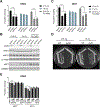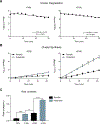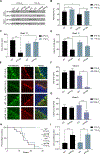Hypoxia Rescues Frataxin Loss by Restoring Iron Sulfur Cluster Biogenesis
- PMID: 31031004
- PMCID: PMC6911770
- DOI: 10.1016/j.cell.2019.03.045
Hypoxia Rescues Frataxin Loss by Restoring Iron Sulfur Cluster Biogenesis
Abstract
Friedreich's ataxia (FRDA) is a devastating, multisystemic disorder caused by recessive mutations in the mitochondrial protein frataxin (FXN). FXN participates in the biosynthesis of Fe-S clusters and is considered to be essential for viability. Here we report that when grown in 1% ambient O2, FXN null yeast, human cells, and nematodes are fully viable. In human cells, hypoxia restores steady-state levels of Fe-S clusters and normalizes ATF4, NRF2, and IRP2 signaling events associated with FRDA. Cellular studies and in vitro reconstitution indicate that hypoxia acts through HIF-independent mechanisms that increase bioavailable iron as well as directly activate Fe-S synthesis. In a mouse model of FRDA, breathing 11% O2 attenuates the progression of ataxia, whereas breathing 55% O2 hastens it. Our work identifies oxygen as a key environmental variable in the pathogenesis associated with FXN depletion, with important mechanistic and therapeutic implications.
Copyright © 2019 Elsevier Inc. All rights reserved.
Conflict of interest statement
Declaration of Interests:
VKM is on the scientific advisory boards of Raze Therapeutics, Janssen Pharmaceuticals, and 5AM Ventures. WMZ is on the scientific advisory board of Third Pole Therapeutics. GR is on the scientific advisory boards of Calico Life Sciences and the Glenn Medical Foundation and is cofounder of Marvelbiome. GR has filed for patents on the interaction of mitochondrial mutants with bacterial siderophore mutations and acetobacteria. VKM and WMZ are listed as an inventors on a patent application filed by Massachusetts General Hospital on the use of hypoxia as a therapy for mitochondrial and degenerative diseases.
Figures







Similar articles
-
Posttranslational regulation of mitochondrial frataxin and identification of compounds that increase frataxin levels in Friedreich's ataxia.J Biol Chem. 2022 Jun;298(6):101982. doi: 10.1016/j.jbc.2022.101982. Epub 2022 Apr 25. J Biol Chem. 2022. PMID: 35472330 Free PMC article.
-
Normal and Friedreich ataxia cells express different isoforms of frataxin with complementary roles in iron-sulfur cluster assembly.J Biol Chem. 2010 Dec 3;285(49):38486-501. doi: 10.1074/jbc.M110.145144. Epub 2010 Oct 2. J Biol Chem. 2010. PMID: 20889968 Free PMC article.
-
The yeast frataxin homolog Yfh1p plays a specific role in the maturation of cellular Fe/S proteins.Hum Mol Genet. 2002 Aug 15;11(17):2025-36. doi: 10.1093/hmg/11.17.2025. Hum Mol Genet. 2002. PMID: 12165564
-
Frataxin and mitochondrial FeS cluster biogenesis.J Biol Chem. 2010 Aug 27;285(35):26737-26743. doi: 10.1074/jbc.R110.118679. Epub 2010 Jun 3. J Biol Chem. 2010. PMID: 20522547 Free PMC article. Review.
-
Iron Pathophysiology in Friedreich's Ataxia.Adv Exp Med Biol. 2019;1173:125-143. doi: 10.1007/978-981-13-9589-5_7. Adv Exp Med Biol. 2019. PMID: 31456208 Review.
Cited by
-
Glucose Metabolic Dysfunction in Neurodegenerative Diseases-New Mechanistic Insights and the Potential of Hypoxia as a Prospective Therapy Targeting Metabolic Reprogramming.Int J Mol Sci. 2021 May 31;22(11):5887. doi: 10.3390/ijms22115887. Int J Mol Sci. 2021. PMID: 34072616 Free PMC article. Review.
-
Mechanism of activation of the human cysteine desulfurase complex by frataxin.Proc Natl Acad Sci U S A. 2019 Sep 24;116(39):19421-19430. doi: 10.1073/pnas.1909535116. Epub 2019 Sep 11. Proc Natl Acad Sci U S A. 2019. PMID: 31511419 Free PMC article.
-
Adaptation of the heart to Frataxin depletion: Evidence that integrated stress response can predominate over mTORC1 activation.Hum Mol Genet. 2021 Sep 22;33(8):637-54. doi: 10.1093/hmg/ddab216. Online ahead of print. Hum Mol Genet. 2021. PMID: 34550363 Free PMC article.
-
Frataxin deficiency promotes endothelial senescence in pulmonary hypertension.J Clin Invest. 2021 Jun 1;131(11):e136459. doi: 10.1172/JCI136459. J Clin Invest. 2021. PMID: 33905372 Free PMC article.
-
Skeletal Muscle Involvement in Friedreich Ataxia.Int J Mol Sci. 2024 Sep 13;25(18):9915. doi: 10.3390/ijms25189915. Int J Mol Sci. 2024. PMID: 39337401 Free PMC article. Review.
References
-
- Achebach S, Selmer T, and Unden G (2005). Properties and significance of apoFNR as a second form of air-inactivated [4Fe-4S].FNR of Escherichia coli. FEBS J 272, 4260–4269. - PubMed
-
- Andreini C, Banci L, and Rosato A (2016). Exploiting Bacterial Operons To Illuminate Human Iron-Sulfur Proteins. J Proteome Res 15, 1308–1322. - PubMed
-
- Anzovino A, Chiang S, Brown BE, Hawkins CL, Richardson DR, and Huang ML (2017). Molecular Alterations in a Mouse Cardiac Model of Friedreich Ataxia: An Impaired Nrf2 Response Mediated via Upregulation of Keap1 and Activation of the Gsk3beta Axis. Am J Pathol 187, 2858–2875. - PubMed
Publication types
MeSH terms
Substances
Grants and funding
LinkOut - more resources
Full Text Sources
Other Literature Sources
Molecular Biology Databases
Research Materials
Miscellaneous

